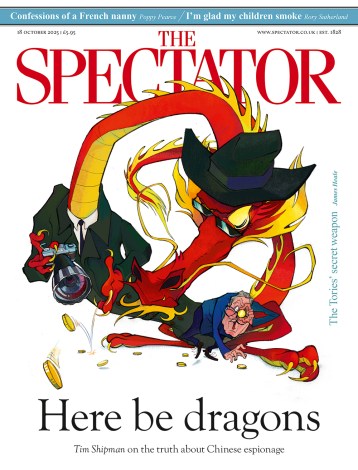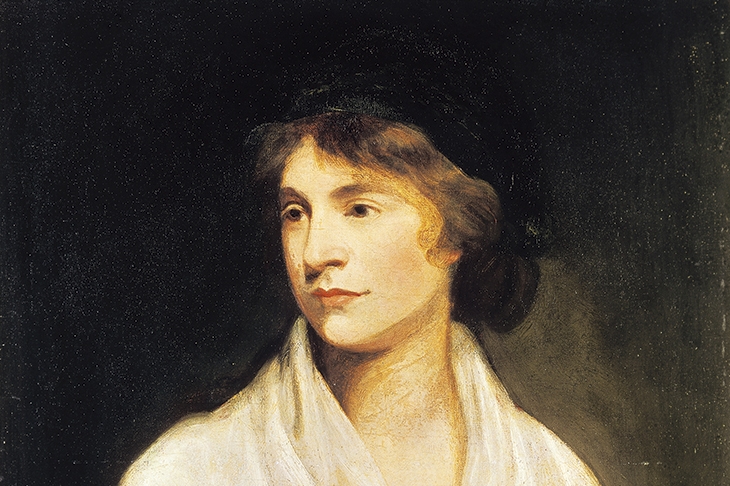What did Mary Wollstonecraft like and love? This is the question Sylvana Tomaselli, a lecturer at Cambridge University, asks herself at the start of her new book about the writer and philosopher who is often described as ‘the mother of feminism’. After the unveiling of Maggi Hambling’s controversial statue in honour of Wollstonecraft on Newington Green last November, and the vitriolic spats between its detractors and supporters that ensued, a book that refocuses attention on the person at the centre of the storm is a welcome relief.
Wollstonecraft, born in 1759, was determined to live independently by her pen. Joseph Johnson, ‘the father of the book trade’, recognised her talent, paid her a publisher’s retainer usually reserved for men, and she produced novels, pamphlets, conduct books, translations, travelogues and a vast number of reviews before she died of puerperal fever after the birth of her second daughter in 1797, aged just 38. ‘The brevity of that life must never be forgotten,’ says Tomaselli.
Much of Wollstonecraft’s writing is condemnatory and cutting in tone, leaving her open to the suspicion of being a killjoy, out of keeping with a permissive modern world she could not have begun to imagine. Here she is, for example, on card games: ‘Cards are the universal refuge to which the idle and the ignorant resort, to pass life away, and to keep their inactive souls awake by the tumult of hope and fear.’ By beginning with what Wollstonecraft actually liked and loved — accentuating her positive rather than negative reactions — Tomaselli gives us an intimate portrait of the passionate, life-loving woman behind the public moralist.
When the Revolution erupted, Mary travelled to Paris to see the events everyone was talking about for herself
She loved the theatre. She found herself moved ‘beyond measure’ by King Lear’s line: ‘I think that Lady is my daughter.’ She loved Hamlet, but was harsh on Ophelia, whom she thought should have pulled herself together rather than drowning in a watery grave. She was besotted with the painter Henry Fuseli, but did not anticipate liking his depictions of Milton’s Eve. She saw some early sketches in the artist’s studio and wrote to her friend William Roscoe to say he must see them for himself, since ‘we have all an individual way of feeling grandeur and sublimity’. The pleasures arising from taste, according to Wollstonecraft, are complex, accidental and ‘almost incommunicable’. When listening to music, that of Purcell and Handel in particular, she felt close to God, ‘from whom all bounty flows’. And above all, she loved nature. Rambling by the side of the Thames, in the fields around Henley, she found ‘the prospects were of such a placid kind, I caught tranquillity while I surveyed them — my mind was still, though active’.
Tomaselli loosely models her book on Wollstonecraft’s own first published work, Thoughts on the Education of Daughters: with Reflections on Female Conduct, in the More Important Duties of Life (1787). Wollstonecraft’s thoughts are discussed under specific headings: Human Nature, Memory, Evil and Perfection, and the Limits of Education. Tomaselli draws on the widest possible range of subjects that interested Wollstonecraft and the rich variety of genres in which she wrote, including personal letters. Through this open-ended structure Tomaselli is determined to avoid ‘isms’, leaving her readers free to apply labels to Wollstonecraft’s thought, but refraining from doing so herself. She argues that the best-known work,
A Vindication of the Rights of Woman (1792), needs to be ‘dethroned’ to allow a clearer view of its author.
Wollstonecraft wrote A Vindication of the Rights of Woman as a sequel to A Vindication of the Rights of Man, which was her riposte to Edmund Burke’s denunciation of the French Revolution. Shortly after Fuseli and his wife rejected her suggestion that she live with them in a ménage à trois, she travelled to Paris to see the events everyone was talking about for herself. Watching the dethroned Louis XVI pass by on his way to execution, she was overcome by fear and unable to blow out her candle that night for the first time in her life.
She began an affair with the businessman Gilbert Imlay, unaware of his involvement in the slave trade, which would have disgusted her. She gave birth to his daughter, Fanny, in the midst of the Terror, and discovered she loved her more than she had thought she would. She found that the little girl ‘got into my heart and imagination and when I walk out without her, her little figure is ever dancing before me’. When Imlay abandoned Wollstonecraft and her illegitimate daughter she tried twice to kill herself. Tomaselli, with characteristic open-mindedness, comments: ‘It was, one could say, out of character, or possibly not, depending on one’s stance on suicide.’
Tomaselli’s argument is that more than the mother of feminism Wollstonecraft was a real, passionate woman in her own right, the mother of two flesh-and-blood daughters, who achieved an astonishing amount in her short and tragic life. The Romantics who came after her believed she was ‘an ideal of a person’; others have characterised her as the ‘first English feminist’, a liberal, republican, neo-republican or utopian socialist. Tomaselli resists all these attempts to fit Wollstonecraft’s life and thought into categories. There was nothing tidy, resolved or finished about her. She absolutely did not want to die when she did; she was sure, as Virginia Woolf pointed out, that she was going to come down to dinner the day after her baby was born and employ a midwife, not a male doctor, and finish her novel called The Wrongs of Women. Instead she left two motherless girls behind in a world she knew was unfit for them to inhabit. Fanny killed herself aged 22; her younger sister became Mary Shelley.
So what would Wollstonecraft think of the statue in her honour, with its idealised nude female figure emerging from amorphous forms of female struggle? Tomaselli discusses Wollstonecraft’s view that art should not, and cannot, replicate nature and her admiration for Ancient Greek sculpture: ‘For only insipid lifeless beauty is produced by a servile copy of even beautiful nature.’ Aesthetic judgment, Wollstonecraft insisted, is an individual matter. She did not think all judgments are equal, but she did think taste cannot be dictated. She had her own views about Fuseli’s Eve, but she thought others should look and think and decide for themselves.
The only thing Wollstonecraft, as she emerges from Tomaselli’s clever and humane book, would have objected to in recent debates is people telling others what to think. Make your own mind up, but don’t tyrannise over others, is her enduring message. It is a message that resonates with other words of hers inscribed on the statue’s plinth: ‘I do not wish women to have power over men but over themselves.’






Comments